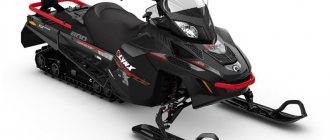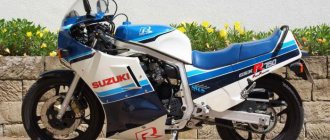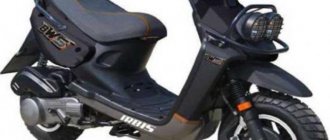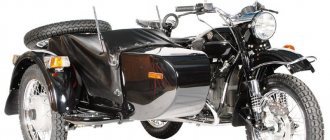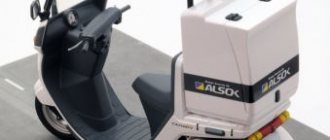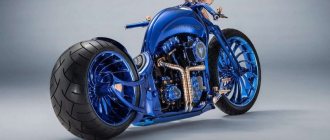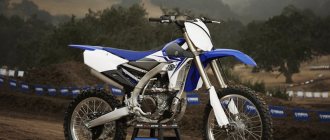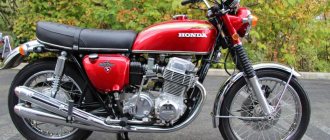All about the Sabur moped (Alpha Sabur)
The Alpha Sabur moped is an inexpensive Chinese scooter, which was produced in two modifications. The first involved the installation of a 50 cubic centimeter engine. The second is a 110cc power plant. The latest model has gained the greatest popularity among owners of two-wheeled vehicles.
The Sabur moped is a kind of mini-bike that is equipped with a gearbox and a four-stroke engine. Such features, combined with low weight, make it possible to provide excellent driving characteristics.
- Specifications
- Instructions
- Wiring diagram (electrical diagram)
- How to set the ignition and adjust the valves
- Where to buy and how much it costs
- Spare parts
Resource of piston scooter: Chinese four-stroke with 139QMB engine
We will consider the most common version of this engine with a cylinder volume of 72 cm3 (many round up to 80) and, accordingly, a piston diameter of 47 mm. The vast majority of Chinese fifty-kopeck cars have such an engine.
The service life of a piston scooter is a relative concept, as it depends on many factors:
- the quality of the scooter itself;
- driving habits;
- timeliness of maintenance;
- quality of motor oil;
- oddly enough, from your luck.
So, in order to decide on a resource, you need to set the initial parameters. This is what we will do:
We take one of the most common Chinese - “Viper”. For example "Viper Storm 50". This scooter has a fairly good quality engine (for a Chinese). Similar models from such manufacturers as Alphamoto, Fada, Skymoto, SpeedGear, Kanuni, Yaben, etc. are of approximately the same quality.
You can drive carefully at a speed of 30-40 km/h and at the same time carry only your butt. Or you can use the moped as a truck and transport, for example, several bags of cement at a time. You can even try to take part in HardEnduro competitions. For those who don’t know, HardEnduro is an endurance race over rough terrain, with a huge number of difficult obstacles to overcome - rocks, logs, jumps, steep climbs, steep descents, impassable mud, etc.
Here, perhaps, we will also choose the middle - we will drive relatively carefully, 40-50 km/h, sometimes give friends rides, and less often - bring home a bag of potatoes.
There are not many options here:
Here, too, everything is simple - we pour good oil, from about 120-130 UAH. per liter (price as of October 8, 2017), it can be more expensive - it definitely won’t be worse. Of course, there is oil for 40 UAH. per liter, but I really doubt it’s worth checking its quality on your scooter.
A piston can die without traveling even a couple of tens of kilometers. Yes, this happens with Chinese scooters. The piston retaining ring, which was inserted crookedly at the factory, may fall out and kill the cylinder. The piston rings may initially be installed incorrectly and get caught in the intake port, and also "GameOver". Due to the untreated crankcase casting, the channel for oil circulation from one half of the engine to the other may simply be closed and, accordingly, everything will end very quickly. And in general, anything can happen - this is China! To our great joy, such cases do not happen often, and one might even say, rarely. We, perhaps, by default will consider that we were lucky with the purchase of a scooter, in the good sense of the word.
- The quality of the scooter, i.e. manufacturer.
- Driving style.
- Timely maintenance. We change the oil every 2000-3000 km.
- Be sure to keep an eye on the air filter element: if it starts to get dirty, wash it, if it starts to tear, replace it.
- We often check the tightness of the air filter pipe, the integrity of the filter itself, and monitor the correct operation of the engine cooling system.
- We check the valves on time (according to the manual) and, if necessary, adjust them.
- Checking the oil level in the engine.
In general, we do everything as it is written in the “book”.
Of course, you can forget about all these details, but this can lead to a global reduction in the life of the piston, and the engine as a whole, up to several tens of kilometers.
So, the big picture
We have a fairly high-quality new Chinese scooter. We drive it moderately carefully, sometimes we load it a little, and we don’t take part in races. We almost always service on time and monitor the technical condition. We pour normal oil. And we were lucky that the engine didn’t immediately seize.
Based on all of the above, and my own experience, I can confidently say that the piston life of such a scooter before the first repair is on average from 15,000 to 20,000 km.
But if we move away from our input data, for example, buy “ga..but”, tighten the operating conditions or “forget” for maintenance, then the service life of the piston can be reduced very significantly.
The longest confirmed mileage before any intervention in the engine that the author of this article has seen is 24,500 km. And it belongs to the FADA 7 scooter. But I think it could be more.
And the shortest mileage before piston repair, not counting the initial factory defects, is 620 km (some distance without oil at all). The result is a completely jammed cylinder and many additional “bonuses”.
So, in most cases, it is up to you to decide how long you can ride the scooter before the first piston repair.
The design of the P-39 Airacobra fighter
The P-39 Aerokora is an all-metal cantilever low-wing aircraft with a semi-monocoque fuselage. The wing is straight, three-spar, trapezoidal in plan with rounded tips. The wing mechanization consisted of Frize-type flaps and slats. The landing gear is retractable, tricycle with a nose strut. The engine is located behind the pilot's cabin and is connected to a three-blade (on the P-39Q-21-25 - four-blade) propeller by a shaft about 3 m long, passing under the cabin floor. The fuel supply was located in the wing tanks.
Access to the cabin was through car-type doors. The composition of the weapons varied depending on the modification and included: 7.62 mm machine guns, 12.7 mm Colt-Browning machine guns, 20 mm Hispano M1 cannons, 37 mm M4 cannons.
Drawing of the P-39 Airacobra fighter
Design
The Airacobra was a single-seat all-metal low-wing aircraft, containing a number of non-standard solutions in its design. The main design feature of the P-39 fighter was the placement of the engine.
Since the plane was “built around a cannon,” they thought, first of all, about how best to place the unprecedentedly powerful weapons.
The easiest way would have been to install the cannon in the camber of the engine - but the lack of a suitable engine was a hindrance. So the power unit “went” behind the cockpit, and the traction screw was driven by an extended shaft. In addition, placing the engine near the center of gravity increased maneuverability.
For the first time, a three-post chassis with a front strut was used on a fighter. In practice, the downside of such decisions was also revealed. The plane became very sensitive to the slightest imbalance and easily went into a tailspin. It took a long time to fine-tune the chassis design.
All Airacobras were equipped with a 12-cylinder V-twin Allison V1710 engine. The prototype flew with a high-altitude engine equipped with a turbocharger, but production aircraft received an engine equipped with a single-stage drive supercharger and “choked” at altitude. During the war, however, the engine design was improved, power and altitude increased slightly.
The engine itself was assessed as very successful - many American aircraft flew with it.
The main caliber of the Airacobra was the 37mm M4 automatic cannon. The development of this weapon began with John Browning. In terms of characteristics, the gun was generally inferior to other systems of the same caliber, but it is worth remembering two facts.
Honda Super Cub
Honda Super Cub
— a scooter produced by the Japanese company Honda with a 50-125 cm 3 engine. Produced with minor changes since 1958; The emergence of the concept of “scooterette” is connected precisely with it. It is the most massive motor vehicle ever produced [1] - the total circulation of the original Honda alone, not counting Chinese copies, reached 100 million units in October 2022 [2] and production continues. The “Super Cub” engine, including various clones, is one of the most common in cheap motorcycles of the 50-150 cm 3 class from manufacturers all over the world.
Content
- 1. History
- 2 Advertising campaign of the 60s in the USA
- 3 Modifications
- 4 Super Cub engine and its clones
- 5 Notes
History [edit | edit code]
Honda Motor Co., a company that started in 1948 with the production of bicycle motors from the remains of military components, and was initially located in a wooden barn, by the mid-50s was already producing full-fledged, although not revolutionary, motorcycles and began to look closely at extensive and complex motor markets of the United States and Europe. The future expansion of the production of affordable motorcycles, according to corporate legend, was based on two ideas. Firstly, in the series of consistent preferences of the poor post-war buyer in Europe and Japan “motorcycle-motor scooter-motorcycle-minicar” there was no place for the motorcycle, and it was necessary to come up with a way to occupy it. Secondly, in the words of the company's then general manager Takeo Fujisawa, addressed to engineers, “if you design a small motorcycle, say a 50 cc, with a cover that covers the engine with all the wires and hoses, I can sell it; If a motorcycle is so easy to operate that you can drive it with one hand while holding a tray of noodles in the other, then every noodle peddler in this country, no matter how many there are, will buy himself such a car.”
The founder, director and leading engineer of the company, Soichiro Honda, heeded the words of the financier and, having previously visited the showrooms of European competitors, set about designing the future “Super Cab”. Before that, among the Honda models there was already a “Cub” - without the prefix “super” - which was an ordinary motorbike with an engine suspended on the side of the rear wheel. The name translated from English means “puppy”, “cub” - they decided to keep it for the new model of the youngest class in the range. But compared to a motorbike, it was already a “super baby”: a normal motorcycle layout, an engine with a kickstarter, a three-speed gearbox and an automatic clutch, advanced cladding, spring suspension and a soft saddle, full-fledged instruments and lights. When the finished prototype was presented to Fujisawa, he stated that he would be able to sell 30 thousand of these devices per month - one and a half times more than the entire Japanese motorcycle market at that time.
A plant was built specifically for the new model in Suzuka with the expectation of producing 30 thousand “Cubs” per month, and after expansion - up to 50, modeled on the Volkswagen Beetle production line in Germany. The plant cost the company 10 billion yen, and experts at the time considered such an investment “extremely risky” and the target American market “saturated.” However, by 1960, the enterprise successfully reached its designed capacity, becoming the largest motorcycle plant in the world. In mass production, the cost of "Kab" decreased by 18%. At the same time, the development of the dealer network was somewhat delayed, and the company was faced with a temporary overstocking.
Over the course of half a century, the Cub has gone through several restylings - the appearance of a cheap mass-produced car greatly affects its sales, even if the mechanical part is perfect. A 4-speed gearbox, electric starter, contactless ignition and other amenities were introduced. 90 and 110 cc versions appeared, as well as a 125 cc version for the 2019 model year. The production of the original Honda was repeatedly expanded by foreign branches - mainly in Southeast Asia, but also in Latin America, Africa (Nigeria) and even Europe (Belgium, 1963). The successful engine was used on several light Honda models - the popular mini-bike Monkey, light motorcycle Honda 70 and others. As of now (2019), Super Cub is still relevant. The original sells well due to traditional Japanese quality, controlled by the company regardless of the place of production. In the Asian and post-Soviet markets, the “native” Honda has been supplanted by even cheaper Asian clones, which, however, are distinguished by very unstable quality of frame metal, welding, cladding and drive chains. The cloned engine remains “indestructible” if basic operating and maintenance standards are observed. Alloy wheels, telescopic forks and front disc brakes have become common on clone scooters.
